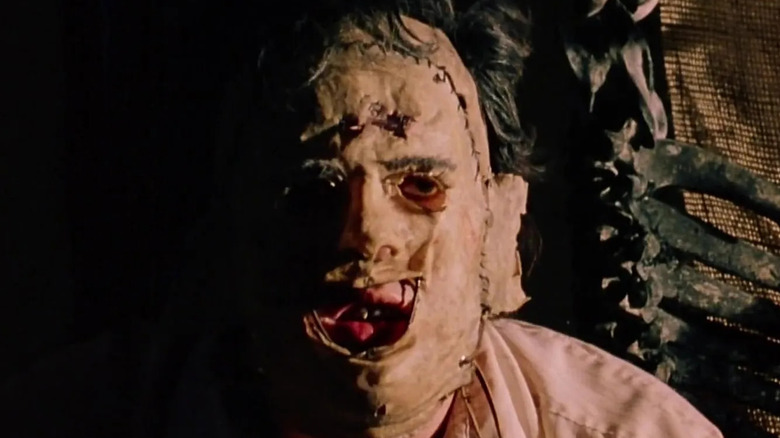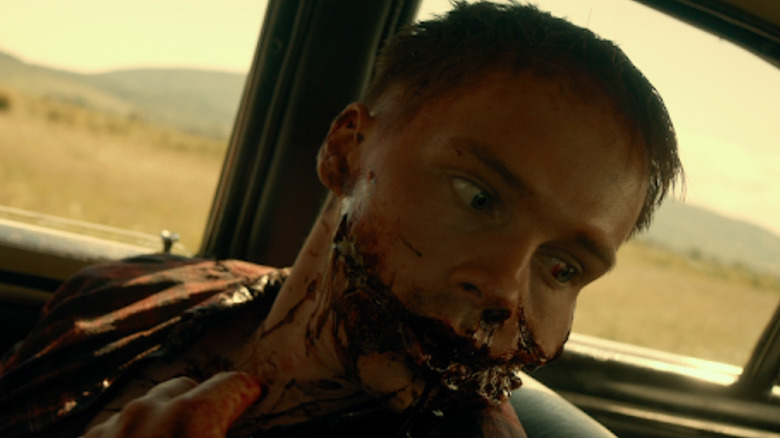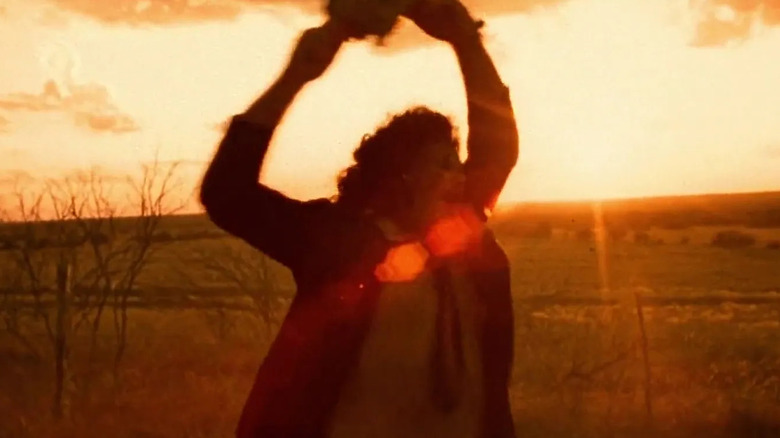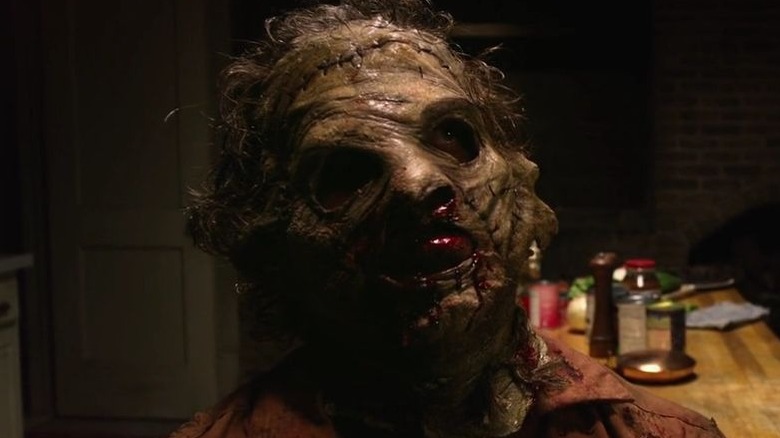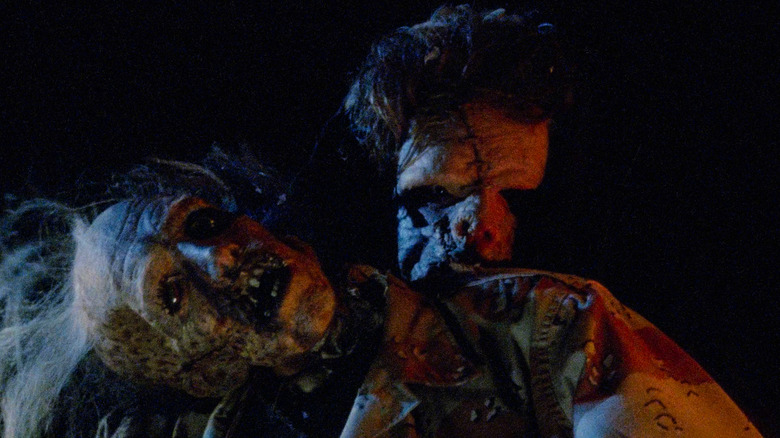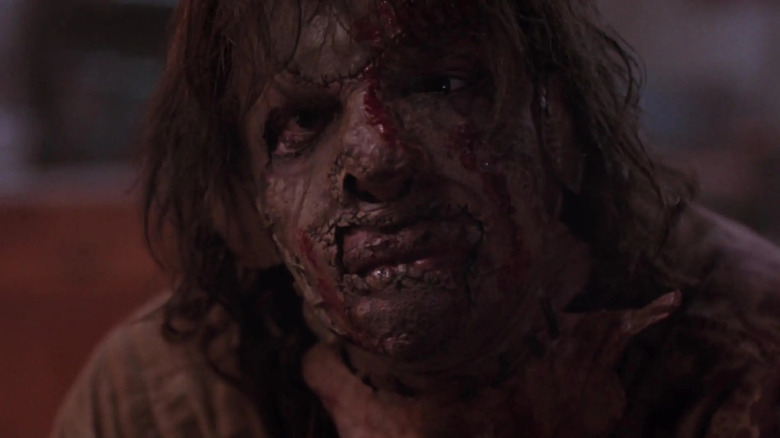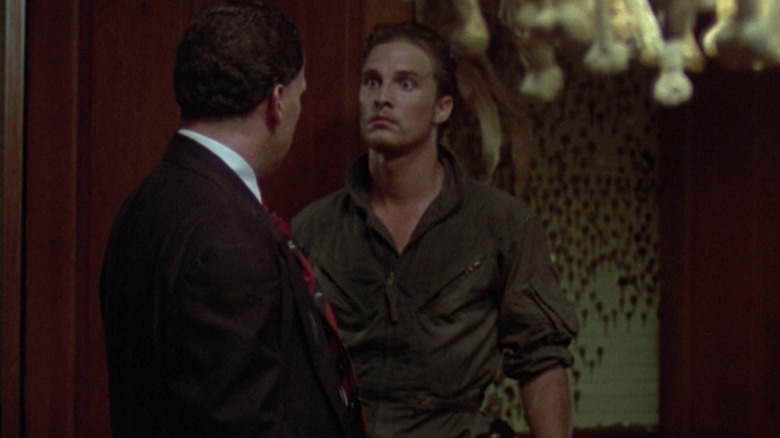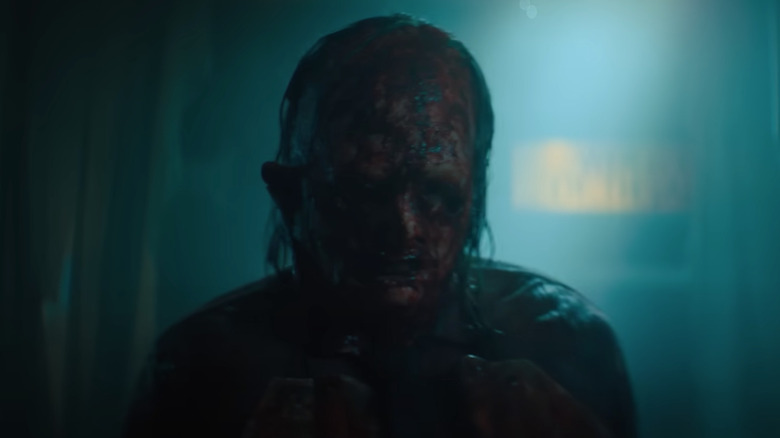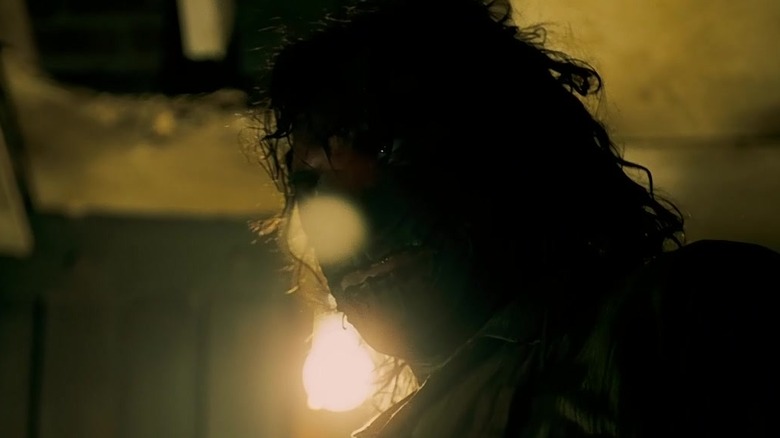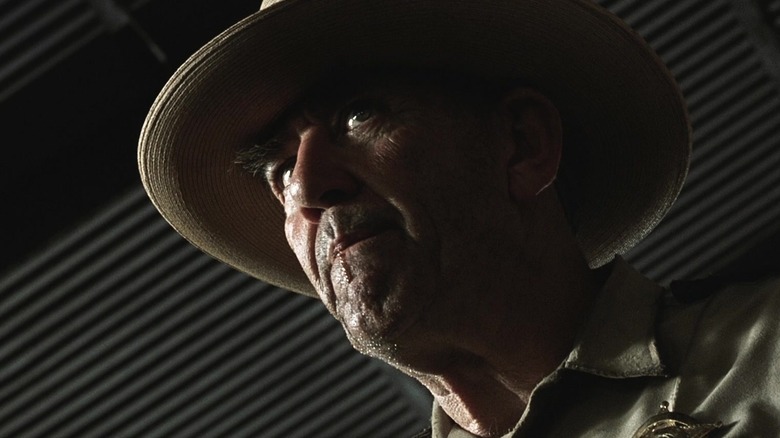The Correct Order To Watch The Texas Chainsaw Massacre Movies
The "Texas Chainsaw Massacre" franchise is a long and tangled string of movies that can be difficult to unravel and get in the right order. The full series is comprised of nine total films released over the course of several decades. With many entries in the franchise going unnumbered and using non-descriptive, interchangeable titles, it can be a headache to even put them into their official release order, let alone put them into their proper chronological order. With sequels, prequels, reboots, requels, retcons, and remakes, it's fair to say that the "Texas Chainsaw Massacre" timeline is a mess.
With that messiness comes quite a lot of inconsistency as well. Not all films in the overall franchise are considered canonical in the worlds of other entries in the series, meaning some films ignore others and erase the backstories established in earlier movies. The intellectual property ownership of the series changed hands almost every time a new movie was made. The brand wound up in the hands of such wildly different parties as The Cannon Group in the '80s and Michael Bay in the 2000s. The franchise never had the type of singular guiding voice behind the scenes that could have ensured a solid continuity from movie to movie, so the series instead wound up as a confusing jumble instead.
If you only aim to see the out-and-out good "Texas Chainsaw Massacre" movies, then you are probably best off sticking to the original 1974 film and leaving the rest of the series by the wayside. However, if you are truly determined to watch the entire franchise from top to bottom, this is the correct order to do it.
1. Leatherface
The second-most-recent movie in the "Texas Chainsaw Massacre" series is the first in chronological order. 2017's "Leatherface" acts as a prequel to the original 1974 film. Beginning in 1955 and later jumping forward to the 1960s, this film attempts to tell the origin story of its iconic titular villain. In what could be considered a controversial move, the main character begins the film not as Leatherface, but as Jedidiah, a seemingly normal child (more normal than usual at least) from a deranged family. After a stint in a mental hospital, a violent escape, several gruesome deaths, and a crude facial surgery, Jedidah eventually becomes his murderous namesake.
While it could have been worthwhile to showcase the nature vs. nurture creation of this iconic murderer, the end result isn't really what most people were looking for, and only serves to make the villain less mysterious and less frightening in the other movies. RogerEbert.com critic Simon Abrams summed up the film's failed attempt at backstory by writing, "It doesn't feel like a loss of innocence, nor does it feel like a gross triumph for misunderstood misfits. It's just a trite ending to an introductory story that never really needed telling." This is one origin story that you might be better off skipping, lest it hurt your perception of the franchise's main villain moving forward, but it's the earliest chronological point to begin for series completionists.
2. The Texas Chain Saw Massacre
Released and set in 1974 Texas, this is the film that started it all. If you only plan to watch one movie in the series, make sure it is the original "The Texas Chain Saw Massacre." This horror classic was directed and produced by Tobe Hooper, who also co-wrote the script with Kim Henkel, who would return to the series as a writer, director, and producer two decades later. The film was extremely controversial in its time and faced a contentious history of censorship and bans, even winding up on the infamous video nasty list. Despite this harsh reputation, much of the film's violence is actually kept off-screen or only implied. It is a credit to Hooper's direction that the movie feels as grungy and visceral as it does while displaying far more restraint than it often receives credit for. It wasn't until later on in the "Texas Chainsaw Massacre" series that the movies began truly wallowing in gratuitous gore.
The story of the original "The Texas Chain Saw Massacre" is extremely simple and was never designed to launch a single sequel, let alone a massive 50-year franchise. A group of young friends travels to an isolated rural home and faces torment and death at the hands of the deranged Sawyer family. While Leatherface would eventually become the main villain and the de facto figurehead of the series, that was not the case in the original. Leatherface makes quite the mark in the original, but he was just one member of the twisted Sawyer household, all of whom leave impressions that are just as large.
3. Texas Chainsaw 3D
Though its gimmicky title makes no mention of it, part of the selling point of "Texas Chainsaw 3D" was that it served as a direct sequel to the original film, erasing the continuity of all the other intervening entries in the series. Arriving in 2013, after the Platinum Dunes remake and its sequel, "Texas Chainsaw 3D" had the potential to be a welcome return to the original canon, but it didn't exactly work out that way.
The film picks up in the immediate aftermath of the events of the 1974 original, except the supposed continuity between the two films is almost non-existent. A large police force has materialized, which was not a part of the first film, and the Sawyer family has drastically grown in size for the sake of having a big shootout to open the movie. The idea of being a direct sequel to the original is dropped pretty quickly, as the film then jumps to the modern day and unfolds like any other slasher sequel.
Since only the film's opening directly follows the original chronologically and the rest of the movie is set long after the next few sequels, "Texas Chainsaw 3D" jamming itself into this spot in the series is mostly just an unnecessary way to muddy up the timeline. Lore-wise, this entry also makes the miscalculated decision to attempt to redeem Leatherface and frame him as a heroic protector-type by the end of the movie. This softening character choice was smartly ignored elsewhere in the franchise.
4. The Texas Chainsaw Massacre 2
The director of the original film, Tobe Hooper, returned to helm the first sequel and would remain the only person who ever directed two movies in the franchise to date. Rather than attempting to recapture the intense and disturbing magic of the first installment, Hooper and screenwriter L.M. Kit Carson took the property in a completely different direction. There is still plenty of violence and horror to be found in this sequel, but "The Texas Chainsaw Massacre 2" veered headstrong into over-the-top dark comedy territory, as exemplified by the film's tongue-in-cheek poster, which parodies the poster of "The Breakfast Club."
The overwhelming financial success and high-profile reputation garnered by the original 1974 classic makes it surprising that the first sequel wasn't made until 12 years later in 1986. As explained by horror host Joe Bob Briggs, the prolonged wait between movies was due to the rights to the first film being in litigation for several years. As an indie fundraising measure, Hooper sold percentages of the film (totaling 140%, oops) to the likes of Texas politicians, a local drug dealer, and the New York mafia. Briggs was a personal friend of Hooper and had a cameo role in "The Texas Chainsaw Massacre 2" that ended up getting cut from the final edit. It was The Cannon Group, known for their over-the-top excess style, who eventually wound up with the rights to the property and produced the film with a relatively small but astronomically higher $4.7 million budget compared to the $60,000 bare-bones budget of "The Texas Chain Saw Massacre." Despite what some of the other movies claim, "The Texas Chainsaw Massacre 2" is the only truly 100% direct sequel to the original and arguably the only sequel that could be called anywhere in the ballpark of being a good movie.
5. Leatherface: The Texas Chainsaw Massacre III
Even though the previous film didn't exactly leave the door open very wide for potential follow-ups, the next sequel followed anyway four years later. The ending of "The Texas Chainsaw Massacre 2" required a little bit of retconning in order for "Leatherface: The Texas Chainsaw Massacre III" to be feasible, but internal logic is obviously not high up on the list of this film's priorities, as it mostly goes off the rails on its own path.
The rights to the "Texas Chainsaw Massacre" property passed on from The Cannon Group to New Line Cinema. Without Tobe Hooper involved in the franchise, a new director took over and the franchise was sent in a new direction. Leatherface was upgraded from one amongst a collection of antagonists to the titular role and the be-all-end-all villain of the series in an attempt to make him the next Michael Myers, Freddy Krueger, or Jason Vorhees. Though a direct sequel in title, "Leatherface: The Texas Chainsaw Massacre III" was pretty much a hard reset for the series. An entirely different cast and crew were brought on board by the new producers, and the simplistic story followed the modern slasher template with a priority being placed on violence and gore. The production was a notorious disaster with the domineering producers releasing a trailer, building sets, setting things in motion before the script was even written, and firing director Jeff Burr just a couple of days into shooting over creative differences before ultimately rehiring him.
6. Texas Chainsaw Massacre: The Next Generation
"Texas Chainsaw Massacre: The Next Generation" had a great deal of potential that didn't have the chance to flourish. Returning to the series for the first time in 20 years was Kim Henkel, who co-wrote the original film with Tobe Hooper. As odd as it sounds, Henkel remains the only person who has ever written and directed a "Texas Chainsaw Massacre" movie solo, and the only person who has written two movies in the series. His presence should have been enough to bring the series back on track, but some egregious behind-the-scenes meddling ruined any chance he had at success.
After the disaster that was "Leatherface: The Texas Chainsaw Massacre III," the rights to the "Texas Chainsaw Massacre" property again changed hands, this time landing under the control of Columbia Pictures. With such a major name in the film industry behind the distribution, it's a bit ironic that "Texas Chainsaw Massacre: The Next Generation" had the smallest and most botched release out of any entry in the entire franchise. The movie was only released in about 15 theaters and received no marketing push from Columbia, who was accused of trying to bury the film. "Texas Chainsaw Massacre: The Next Generation" was first released in 1995, then re-released in 1997 after its two stars (the then-unknown Renée Zellweger and Matthew McConaughey) had blown up in popularity. Both releases were extremely limited and were total financial failures.
This re-release was doomed from the outset as McConaughey's new management at CAA sought to prevent the film from being seen, and Columbia complied. This led to a lawsuit between the film's producers and McConaughey's CAA representation for "inter alia, tortious interference" in the film's distribution. The outcome of the lawsuit proved largely irrelevant as the damage had already been done, and the fate of "The Next Generation" was sealed with a pathetic box office return of just $185,000. The future of the mainline canonical series was effectively dashed, but the property wasn't immune from being remade or rebooted.
7. Texas Chainsaw Massacre
Even though the film serves as a reboot, and the title gives no indication of it, 2022's "Texas Chainsaw Massacre" is a direct sequel to the 1974 original. After the departure that was the Platinum Dunes timeline, the Netflix original "Texas Chainsaw Massacre" was a return to the original canon. This 2022 "requel" is set in the present day with modern technology and talking points like cancel culture and gentrification factoring into the plot. As the latest franchise entry, it directly follows up on the events of the original film decades later. Similar to the 2018 "Halloween" reboot, all of the other "Texas Chainsaw Massacre" sequels are ignored in favor of establishing a new canon.
The door is left wide open at the end for future sequels to continue the series. "Texas Chainsaw Massacre" was met with a rather brutal reception from critics, with some questioning what the point of the movie was, and others saying it was time for the franchise to end. Despite how widely disliked it was, "Texas Chainsaw Massacre" performed extremely well on Netflix in terms of viewership, so the series is likely to continue into the future.
8. The Texas Chainsaw Massacre: The Beginning
After the practically non-existent box office results of "Texas Chainsaw Massacre: The Next Generation" killed the series, the only viable option left for the franchise was to remake it. The 2003 remake established a new timeline and canon, and when it was a huge financial success, a follow-up went into production. Rather than making the next movie a sequel, they instead opted to go the prequel route with "The Texas Chainsaw Massacre: The Beginning." Just as "Leatherface" aimed to provide an origin story for the original timeline, "The Beginning" does the same for the remake canon.
The film begins in 1939 and showcases the meatpacking-plant birth of the baby who would grow up to become Leatherface. The narrative then jumps three decades into the future and primarily takes place four years before the events of the 2003 film. What follows is all of the murder and cannibalism that the series is known for. This prequel still enjoyed a solid box office return but was nowhere near as much of a whirlwind success as the remake, while also costing substantially more to produce. Further entries in the remake canon never followed.
9. The Texas Chainsaw Massacre
After the final outing in the original timeline was badly fumbled with the release of "Texas Chainsaw Massacre: The Next Generation," the rights to the property changed hands once again. Now, Michael Bay was in charge of the IP and decided to produce a remake of "The Texas Chainsaw Massacre" under his production banner Platinum Dunes. The company focused primarily on big-name horror remakes throughout the 2000s, including "A Nightmare on Elm Street," "The Hitcher," and "The Amityville Horror," along with a reboot of "Friday the 13th."
The canon of the original 1974 film was set aside in favor of establishing a new one. The psychotic Sawyer family has been rebranded as the Hewitt family amongst numerous other changes, such as introducing a prominent sheriff character played by R. Lee Ermey. With the previous entry in the franchise being such a financial disaster, this remake was a risk that paid dividends. The 2003 "The Texas Chainsaw Massacre" became the highest-grossing film in the entire franchise by more than double the second-highest-grossing entry. A prequel was released three years later, but a sequel to the remake never materialized. The second "Texas Chainsaw Massacre" timeline came to a swift close chronologically with the end of the remake.
